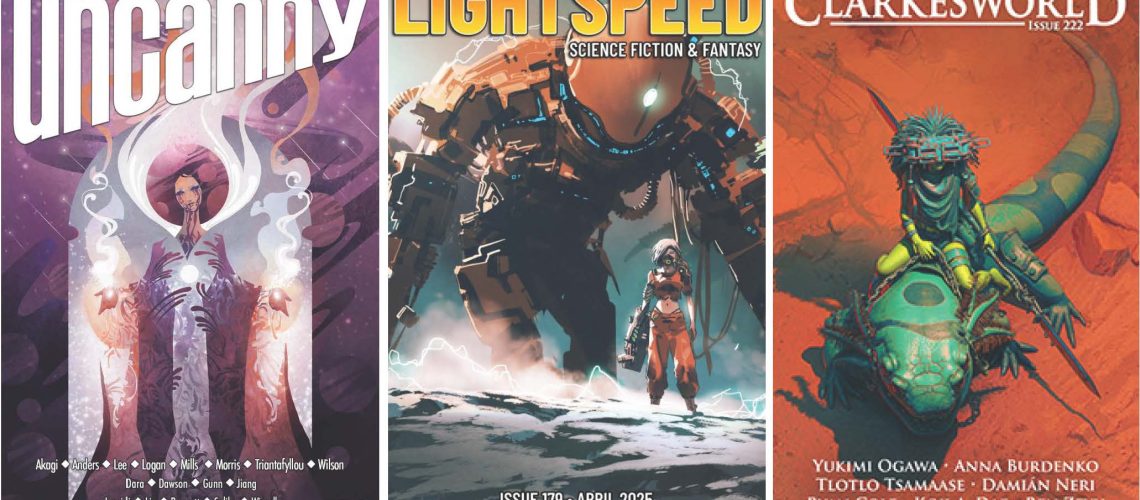My favorite stories from March and April all lift up the importance of human connection in one way or another. In “10 Visions of the Future; or, Self-Care for the End of Days” by Samantha Mills (published in Uncanny Magazine Issue 63), the narrator peers into different possible futures, many of which involve cultists unleashing otherworldly and eldritch horrors. In “The Price of Miracles” by Nigel Faustino (published in Lightspeed Magazine Issue 179), the assets of a deceased god are up for auction, and bidders have to offer something more precious than mere money to get what they hope for. Lastly, in “Hook and Line” by Koji A. Dae (published in Clarkesworld Magazine Issue 222), an elderly psychic medium aboard a generation ship faces the hard truth that their community may not be able to maintain a connection to their ancestors from earth after she passes away.
“10 Visions of the Future; or, Self-Care for the End of Days” by Samantha Mills
In this story, the narrator buys a witch’s ball that lets them peer into different futures. The futures are not good. Some of them are not good in mundane ways (global warming, pandemics, the pains of capitalism), but many of the futures are awful in supernatural ways. Across these futures, doomsday cultists unleash eldritch terrors, literal hellfire rains down upon the neighborhood, and “the demon warlord Escarioth lays claim to our neighborhood,” to name just a few things gone wrong.
I love how playful and creative the awful, otherworldly horrors are. Don’t get me wrong — these things are nightmarish and I wouldn’t wish them upon a soul, but it’s fun to read about them. The story quickly jumps from one possible future to another and doesn’t dwell in the fear and pain of it all, so it’s easy to appreciate many of these horrors as beloved or inventive genre tropes. Even as nightmares become real, the narrator is often optimistic and upbeat, noting all of the good things that are present even in the darkest timelines, good things like cats, amigurumi, and baking bread. I find it heartwarming the way the narrator continually makes space for appreciating life’s little (and biggest) pleasures amidst it all.
This story is suffused with an activist energy that I loved. Throughout these horrific possible futures, the narrator befriends and helps their neighbors and fights and protests against what they can. For a story filled with literal hellfire, it’s surprisingly relatable, probably because lately our world feels quite a bit like it’s going to hell, and this literalization of the metaphor worked really well for me. It makes for a story that made me feel overwhelmed but seen, tired out but motivated, fearful yet inspired to act from a place of love and kindness.
If the apocalyptic genre tropes sound fun, or if you appreciate speculative stories that resonate with the current political moment, check out “10 Visions of the Future; or, Self-Care for the End of Days” by Samantha Mills.
“The Price of Miracles” by Nigel Faustino
The narrator and their partner Jules attend an auction, but it’s not like one you’ve ever heard of before. The narrator has been losing their sight to a degenerative eye condition, and at this auction, they are hoping to buy a miracle from a defunct god.
The only treatment option available that the doctor knew of was a miracle from a specific medical god, Matinos, who had been born a few years ago, but before I could even apply for it, the god had gone belly-up, as these new gods tended to. Hence, the auction for its assets.
The assets of defunct gods are of course priceless, so rather than money, bidders offer up rare and abstract treasures such as “a golden calf” or the “Last prophecy of Nostradamus.” I love how this story blends gods and fantasy alongside the world of contemporary commerce. It makes for a fun, creative, and compelling world, and I’d love to read more stories set in this universe or in similar settings.
I found it gripping to see how far the narrator and Jules will go to get the miracle they desire, especially since they come from a modest background and are bidding against people with upsetting amounts of privilege and wealth. This story is set in San Francisco, which feels perfect to me. As someone who lives in nearby Silicon Valley, I am routinely disgusted by wealth disparities and class inequality, and this story captured that inequality and that disgust so well. For example, after someone buys “an ever-burning pyre for a recipe for pho,” the narrator reflects: “Maybe the bank didn’t need the pho. But they did like the idea of being the only ones with it. That was enough.” Imagine desperately bidding for something against a person like that. So while the setting and concept lured me in, this made for a compelling climax: watching the narrator and Jules risk more than they should and reflect on what they could give up and what they wouldn’t dare.
If you enjoy stories that blend gods and magic into modern life, or if you rage against the inequities of contemporary life, this story is for you.
“Hook and Line” by Koji A. Dae
Isabella is an elderly psychic medium on a generation ship, a spaceship traveling from Earth to a new world on a voyage that will literally take generations to complete. Isabella and other “spiritualists, shamans, and mediums” have tried “to carry our ancestors, and all the knowledge they hold, with us to a new planet.” It’s not going well. Isabella is the last living medium with personal memories and experiences of Earth, and without those the younger people born on the ship struggle to connect to their ancestors. To make matters worse, the temple that Isabella oversees is at risk of being converted to a movie theater.
I love how this story looks at generation ships from the perspective of mediums and spiritualists. It’s not an angle I’ve come across before, and I really liked it. Change is inevitable for communities on generation ships, and there is a lot they stand to lose as elders with direct experience of Earth pass away. That must be especially true for spiritualists, shamans, and mediums who commune with deceased ancestors. In their voyage across the galaxy, their connection to their ancestral lands will surely weaken, and what if their ancestors’ spirits remain tethered to their homeland? Even if you are not interested in psychic mediums, you can read this story as a metaphor for the challenges that those on generation ships will face when it comes to preserving their cultural heritage. It’s easy to see both how others on the ship wouldn’t care too much about “kooks who believed in ghosts,” and it’s also easy to see that for a character like Isabella, the stakes here would feel really high. It makes for an interesting perspective and for a compelling story.
I also appreciated the relationships in this story. Isabella has an apprentice named Timothy, a man in his early thirties, who takes Isabella’s spiritualism seriously but who struggles to form a connection to a planet he’s never experienced. Isabella and Timothy have a genuine and tender relationship. While they both struggle to fully understand each other’s experiences and context, they both want to better understand and care for each other. I especially appreciated their relationship because I find respectful, honest, and intimate intergenerational relationships like theirs to be all too rare. Meanwhile, Isabella has a more comical relationship with Anna, who is seeking to repurpose the temple as a movie theater. They mostly correspond via short, standoffish messages, but as the story progresses, they do move toward genuine dialog with one another.
“Hook and Line” is a thoughtful and touching story. If the concept sounds enticing, or if those relationships sound meaningful to you, you should definitely check it out.







